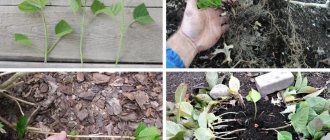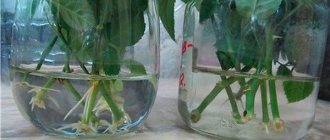A rose is the best decoration of a garden and a real pride of a gardener. Growing healthy and beautiful roses is not easy, but the result will meet all your wildest expectations, filling the air with an incredible aroma and pleasing the eye with dazzling beauty. Of course, growing roses is a real art, and propagation of the Queen of the Garden requires not only love and patience, but also a certain level of knowledge, representing a whole science, which we will try to master together with the Encyclopedia of Roses.
Rose propagation methods
Roses can be propagated in two main ways: seed and vegetative. At the same time, some experts suggest considering the grafting technique as a separate method, which still more often refers to vegetative propagation.
The use of the seed method of propagating roses is significantly limited, since most varieties do not always transfer their aesthetic properties to seedlings, however, this method is the main one in the practice of breeding new species to obtain a strong rootstock. The exception is park roses, which reproduce well by seed.
Vegetative propagation is represented by several methods, the most common of which are the following options:
- cuttings;
- dividing the bush;
- rooting by layering;
- propagation by root suckers;
- graft.
Let's take a closer look at each of the methods presented above and reveal the secrets of rose propagation, which will come in handy for gardeners who dream of their own rose garden.
When is the best time to reproduce?
The propagation of roses can be divided into the following periods: spring, summer and autumn. Reproduction in summer is most successful. Due to the fact that planting is done in warm soil, the root system is well established and grows.
In order to propagate roses in the spring, planting material is prepared from the end of March. In April, seedlings are planted in special containers or on racks.
In the fall, before insulating roses for the winter, the branches that have been cut are cut into plastic containers. The material is planted into it in the usual way.
It is preferable to propagate roses in summer
Growing roses requires patience. Which propagation method to choose is up to each gardener to decide for himself. Each method has its own advantages and disadvantages.
Subtleties of seed propagation of roses
Rose seeds
In order to grow roses from seeds, the latter can be purchased at the store or collected from your garden. If you decide to prepare the seeds yourself, it is best to collect rose fruits at the end of August, when they are not yet fully ripe and are just beginning to turn red. The fact is that seeds obtained from unripe bolls have better germination and form more viable plants. You should not collect seeds from fruits that are susceptible to rotting, since the resulting material is not suitable for planting.
When removing seeds from the fruit, it is necessary to carefully and thoroughly clean them of pulp, after which the resulting grains are treated with a solution of hydrogen peroxide for 20 minutes. It is best to carry out this manipulation using a sieve. This procedure is aimed at protecting the seed from microbial spoilage and mold. Most often, rose seeds have different shapes and size characteristics, but this should not confuse the gardener, since these parameters cannot significantly affect the germination level of the seed.
Having received the seeds, you can grow roses from them both indoors (in a container) and directly in the garden. Depending on the conditions created, the seed germination technology will be slightly different.
Trannoy method
How to propagate a domestic rose at home? Use this productive method, but in this case you will have to prepare the shoots before cutting them into cuttings.
- During the flowering period (summer months are optimal), you need to select strong shoots, remove their tops and two leaves.
- Next, you need to carefully monitor the plant - do not miss the moment when the buds begin to swell on the selected stems.
- The stem is cut into cuttings when the buds swell, but young leaves have not yet appeared from them.
- The cuttings should be on average 20 cm long. Remove all leaves from them except the top two.
- Fill a pot with soil suitable for growing roses and make a hole in the center. into which stick all the cuttings obtained from the bush. In this way, several sprouts will take root, one for sure! Water thoroughly.
- Cover the top of the pot with a plastic bag, or cover the cuttings with a plastic bottle without a bottom and without a lid.
Next, maintain soil moisture and loosen it steadily, because during rooting it is important for oxygen to reach the developing roots.
Germinating rose seeds at home
The entire process of growing roses indoors can be divided into several successive stages:
Preparation for statistics. A cotton pad or small piece of cloth is generously moistened with a solution of hydrogen peroxide. Place rose seeds on the resulting damp cloth and cover with the same cotton pad. Statification. Seeds, wrapped in a damp cloth, are placed in a plastic container or plastic bag and placed in the refrigerator. It is better to place the resulting container in an area where the temperature is about +5 ̊C. The seeds should remain in this state for about two months. At the same time, you should regularly check and maintain the moisture level of the fabric. Germination. Statified seeds are transferred to a pot with soil or peat and conditions for germination are created: t - 18-20 ̊C, active lighting time about 10 hours, regular moderate watering. It is better to mulch the soil with perlite. Hardening. Before transferring the rose to natural soil, it should be prepared for environmental conditions by taking the pot outside every day, gradually increasing the residence time. Disembarkation. The best time to plant roses obtained in this way in natural soil is May. Roses are planted in pre-prepared holes, choosing a warm, well-lit place.
How to propagate roses in the fall from cuttings
Experts believe that planting roses from cuttings under jars in the fall is very simple. Even a beginner can cope with the task. You just need to follow the advice of experienced gardeners and step-by-step instructions.
Preparing the pot
You can root roses with cuttings in the fall at home and in a pot. The most common containers with a volume of at least 1 liter will do. This is true for cases when roses will be transplanted into open ground in the spring.
If you plan to continue to grow the flower in a pot, you should choose a larger container. Fine gravel or any other suitable composition for drainage should be placed at the bottom of the container.
Priming
Roses love light soil. You can prepare it yourself by mixing turf soil, peat, sand in a ratio of 3:1:1. It is permissible to add a little coconut filler for loosening. Some gardeners prefer to put vermiculite.
The prepared mixture must be poured into a pot, spilled with a weak solution of potassium permanganate or Fitosporin. It is not recommended to calcinate the soil. This kills not only pathogenic but also beneficial microorganisms.
It is very convenient to use ready-made universal soil or a special soil mixture for roses. It contains everything that is necessary for the rooting and development of cuttings. But even the finished substrate must be shed with potassium permanganate.
Pre-planting preparation of cuttings
Rose seedlings are sold by cuttings in specialized stores. But you need to understand that these are ordinary branches, cut according to all the rules from the bush. You can even use cuttings from ordinary roses from a bouquet.
Many people have a desire to root flowers given by loved ones. The bouquet quickly withers, and if you plant cuttings on the site, they will remind you of the gift for many years. But not all roses from flower shops are cut. They are often treated with special compounds to ensure they last a long time. This reduces the survival rate of the branches.
Cut cuttings can be planted in a flower garden or in pots immediately. But you need to take into account that for better survival it is worth leaving 2 leaves on top. This is additional food for the branches. When it is necessary to prepare cuttings for long-term storage, all leaves are removed.
Rooting rose cuttings in water
You can root a rose in water. Many gardeners use this technique. Roots form much faster in water. The process looks like this:
- You need to pour water into a jar or any other container and place the cuttings in it with the oblique cuts down.
- The water needs to be changed every 2 days. To prevent it from stagnating, you can add a little Fitosporin to it. This will prevent the rapid growth of microbes.
- When roots 0.5-1 cm long form on the branches, it’s time to replant them.
In this condition the survival rate is very good. There is no need to wait for the roots to grow very long. This makes transplanting difficult. Such cuttings take root worse.
Planting in pots
After all the preparatory procedures have been completed, you need to plant the cuttings in pots. This must be done in the following sequence:
- Treat the cuttings by holding them for 30 minutes in a solution of potassium permanganate or Fitosporin.
- Spill potassium permanganate solution onto the soil in the pot.
- Stick the cutting into a pot of soil, and this must be done at an angle (this is how rooting occurs better). Planting depth is 2-3 cm (or 2 eyes), and you need to make sure that 1-2 buds remain on top.
- Pour plenty of warm water (possibly with the addition of Fitosporin).
- Sprinkle a little sand on top to prevent a crust from forming.
- Cover the cutting with a cut plastic bottle (top part with a lid) or a glass, jar or plastic bag. This creates a greenhouse effect, which means the cutting will be constantly moistened and will not suffer due to the dryness of the room air in winter.
Germinating seeds in natural conditions
The procedure for germinating seeds in natural soil is much simpler, but the survival rate in this case will be much lower. In order to germinate seed in the garden, it is enough at the end of August, immediately after collecting and processing the seeds, to plant them in the ground, lightly sprinkling them with earth. Next, the soil is slightly moistened and covered with covering material, which protects the ground from freezing in winter. In the spring, the planting site is cleared and the seeds are waited for germination. You should be prepared for the fact that roses that were obtained by seed propagation usually produce rather weak and short-lived flowering in the first year, but by the next summer the bush forms full buds.
Lignified cuttings method
This method is perfect for breeding park roses or hybrid ones (for example, tea varieties or rugosa varieties).
The features of this technology are:
- It uses lignified cuttings.
- The stems must be ripe and smooth, 3-6 mm thick. They are prepared in the fall.
- In spring, cuttings 9-11 cm long are made from the stems.
- The cuttings are placed in water.
- Next, the shoots are planted in the ground and watered abundantly.
Important! Before digging in the cuttings, the soil is fed with fertilizers. They are planted at a slight slope to a depth of 7 cm.
Vegetative propagation of roses
Vegetative propagation of roses
The ability for vegetative propagation is a unique property of plant organisms, which is manifested by classical regeneration. This process consists in the fact that the plant is able to completely restore its body from a separate part through active cell division. The main advantage of vegetative propagation is the complete predictability of the results, because the resulting plant will have all the characteristic features of the mother’s body.
If the rose was obtained by vegetative propagation, it is said to be a root-capable plant, which can form a new young shoot after the death of the above-ground part.
Chinese rose propagation
Chinese rose (hibiscus)
You can propagate Chinese roses or hibiscus yourself at home, and there are several useful tips on how to do this more easily.
Drained soil is poured into a plastic cup with a holey bottom, and hibiscus branches cut from the top of an adult plant are inserted into it. Before planting, a cut of each branch is lowered into a growth simulator. Plants are watered.
The glass with the seedling should be covered with a transparent box to create a greenhouse effect. When the plant takes root, new young leaves appear on it. This is a sign that it is ready to be transplanted to a permanent place of growth.
Having studied useful information on how to propagate a rose by cuttings and using the recommendations on when to cut a rose, you can safely get down to business. The positive result of breeding the royal flower will bring only joyful emotions to the gardener.
Propagation of roses by offspring
The method of propagating roses by separating root suckers from the mother plant is most suitable for park varieties, since they produce quite a lot of so-called “children.” The technique involves transplanting small free shoots, which usually form near the mother rose, most often forming on the southern side of the plant. The method of separating offspring is quite simple, but does not always demonstrate a high level of efficiency.
You can get a rose by propagating by offspring by carefully separating young straight shoots from the maternal root system. It should be understood that newly formed offspring are not ready for independent survival, due to the absence or imperfection of their own root system. Before separation, the plant should be allowed to acquire roots and gain strength. This requires endurance, because the formation of a full-fledged root system takes about a year. It is best to replant in the spring, when the soil has already warmed up sufficiently and the risk of cold weather returning is minimal.
Advice. In order to stimulate the formation of additional roots and get a beautiful bushy plant, when replanting, prune the young stem, removing a third of the length of the shoot.
How to grow varietal roses in a greenhouse: description of technology
The most convenient and fastest method of growing roses is the greenhouse method. After planting, flowering appears within a month. The main components of successful cultivation are a high greenhouse and high-quality varieties of roses.
First, let's look at the greenhouse. To grow rose seedlings in a greenhouse, you need to create certain conditions:
- Ensuring correct temperature conditions and ventilation. The temperature should not be higher than +25C
- Mandatory presence of drip irrigation
- Monthly fertilization of seedlings
- An area that will provide sufficient distance between seedlings
There should be enough light in the greenhouse, but not thanks to direct sunlight, but to diffused light. Otherwise, the buds will begin to “burn out” from the scorching sun and the color will not be what you expected.
Growing roses in a greenhouse
Roses love a sufficient amount of moisture - water them at least three times a week in the first months after planting. It is better to create drip irrigation in the greenhouse, so the seedlings will be moistened moderately.
For beautiful bushes, many gardeners use a secret such as filling the greenhouse with carbon dioxide. The pipes are laid out between the rows and a little substance is released into the greenhouse. This product has a positive effect on the yield and beauty of roses.
In winter, when daylight hours are short, it is necessary to provide the flower garden with artificial lighting lamps. This is a rather expensive procedure, because you need to supply the rose with light for at least 12 hours, since if the lighting is not enough, the bushes will form weak, and the color of the leaves and buds will be dull.
Greenhouse roses can delight with their beauty all year round
The advantage of growing roses in a greenhouse is that they bloom all year round. If you intend to seriously engage in this business, then you should find buyers from flower shops. Thus, you will not only be pleased with the pink splendor, but will also have the opportunity to make good money.
Rose varieties for greenhouse cultivation:
- Rose Gaujard – crimson color of roses
- Casanova – yellow roses
- Carina – soft pink color of roses
- Black Baccara – very dark, dark cherry roses
- Lolita – orange color of roses
- Abracadabra - a variegated rose with a cherry and yellowish pattern on the petals
- Memory (Memoire) – white rose
- Pascali – light cream, almost white color of roses
- Queen Elizabeth – pale pink rose color
- Norita – bright cherry roses
Reproduction of roses by layering
Propagation of roses by layering is excellent for shrubby, climbing and groundcover plant varieties. The fact is that propagating roses by layering is the priority and most effective way to obtain a plant that has all the qualities of a mother rose, but it is only suitable for those species that have strong and sufficiently long shoots. It is best to start the process of propagating roses in this way in early spring, performing the following steps in succession:
Carefully dig up the soil near the rose bush, without damaging the root system of the plant and removing all existing weeds. The loosened soil is mixed with some peat and sand. We select the shoot of the mother rose, which has the most superficial location, and remove all the leaves. In the area of one of the lower buds, make a neat circular cut and insert a match or a sliver of wood into it. Make a small depression (about 10 cm) in loose and well-moistened soil near the bush. The selected and pre-cut shoot is bent so that the upper part of the trunk is in the prepared hole and sprinkled with earth. The soil must be compacted well so that it holds the buried shoot. If the trunk has a too dense and elastic base, it can be secured with special arms made of wire or tied to a metal peg. The cuttings are watered regularly. In summer, especially in hot weather, watering must be done daily, which will promote rapid root formation.
Thus, by the beginning of autumn, the cuttings form their own root system. At this time, the rooted shoot can be separated from the mother rose and transplanted to a new location. Some gardeners, to increase the likelihood of survival of the cuttings, recommend replanting only next spring.
Another option for propagating the Queen of Flowers by layering is to obtain vertical shoots, which is more often used for the industrial production of seedlings. In this case, the rose is trimmed short, leaving only 5 cm above the ground, after which it is hilled up so that the entire short sprout is covered with loose soil. Hilling continues as the plant grows, using loose, well-moistened soil for this purpose. In the fall, gradually removing the soil, the rooted individual cuttings can be separated from the mother plant and transplanted to a new location.
Vertical layers
This method is used for those varieties of roses that tolerate pruning well. Before autumn, the bush is pruned, leaving branches 7 cm above the ground. In the spring, the shoots will begin to grow, and when they become 2 times longer, they need to be completely earthed up. The same should be done throughout the summer. At the same time, the hill is periodically watered, but so that the soil does not wash away.
After the leaves fall on other roses, the hill is carefully raked so as not to break off the sprouts, and they are cut off along with the overgrown roots, and then planted in a new place.
Propagation of roses by cuttings
Propagation of roses by cuttings
Propagation of roses by cuttings is one of the simplest, most accessible and effective ways to obtain a healthy bush. This technique is so unpretentious that it allows you to reproduce even flowers collected in a bouquet. This method is actively used for miniature and polyanthus varieties, as well as for Floribunda roses.
Proper cuttings involve obtaining a viable plant in the shortest possible time. To obtain cuttings, you should take a healthy and fairly strong one-year-old shoot, which should have a thickness of about 5-6 cm. A cutting is the middle section of a rose shoot, obtained by two prunings. The top pruning is done just above the bud (2-3 cm), while the bottom pruning can be done just below the bud. The cuts should be made with a very sharp tool, preferably a razor blade, and have an angular surface.
Preparing cuttings for planting involves removing all lower leaves. It is allowed to leave two leaf plates at the top, but the surface of the cut shoot will have to be cleared of all thorns. Before planting, the lower cut must be treated with a special growth stimulator.
Planting can be done in several ways:
- Classic planting in loose soil at an angle of 45°.
- Rooting cuttings in a greenhouse.
- Planting cuttings under jars, etc.
You will find a detailed step-by-step description with photos of how to grow roses from cuttings on our website.
Regardless of the chosen method of rooting the cuttings, fertile, well-moistened soil should be used, which will increase the efficiency of this propagation technique. Interestingly, the cutting method is better suited for varieties with dark flowers - burgundy, deep pink, red, etc. The percentage of rooted cuttings for plants with light flowers is significantly lower.
Propagation of domestic roses
An indoor rose is a decoration for any home. With good care, it pleases with its flowering all year round. But the rose bushes grow old and fade away. In order not to be left without your favorite flower in the house, you need to learn how to breed it.
Indoor rose
House roses are propagated by germination and there is useful information on how best to do this, which every housewife can use without any effort if desired.
A young strong branch with buds separates from an adult rose bush. It is placed in a vessel with water, which should be changed occasionally and some growth stimulants added to it for faster germination. All that remains is to wait for the roots to appear.
After the roots have sprouted, the plants are planted in pots with special soil for roses and covered with a transparent glass vessel for rooting. Occasionally, the future rose is watered with settled water. If everything is done correctly, the fresh young bush will soon bloom.
Reproduction by dividing the bush
This method is only suitable for adult, healthy bushes with many full-fledged shoots. In order to divide one bush into several individual plants, it must be completely dug up without damaging the root system of the rose. It is best to do this in early spring, since after planting individual parts of the plant, they will need some time to recover in favorable conditions, which corresponds to warm, sunny weather. The dug out bush is pruned, removing two-thirds of the shoots and one-third of the roots. Next, the plant is divided using pruners, previously treated with a solution of any antiseptic, into several separate parts, each of which must have a full-fledged part of the root system and one healthy shoot, with at least two buds.
Roses obtained in this way are planted superficially, deepening the root system by 5 cm into well-loosened and fertilized soil. Watering such a young plant must be regular in order for the plant part to take root well and regenerate. In this way, a full-fledged bush with abundant, long-lasting flowering can be obtained within 1-2 years, after dividing the mother plant.
Benefits of autumn rose cuttings
Cuttings from rose bushes in the fall is the easiest way to propagate. Rooting of cuttings occurs quickly and painlessly; seedlings form a root system and prepare to winter.
Even in the event of severe frosts and the death of the above-ground part of the bush, the underground buds will sprout new shoots.
Experienced flower growers take cuttings not only from shoots obtained during routine pruning of rose bushes, but even from roses presented in a bouquet.
Roses propagated by cuttings in the fall will produce abundant shoots in the spring, and a year later they will be ready to bloom.
Rose propagation by grafting
Grafting is a technique that is based on the artificial merging of a cutting of one rose, called a scion, with the base of another plant, in this case called a rootstock. Simply put, this method of propagation involves the grafting of a healthy rose cutting of any variety to the rootstock of a frost-resistant and drought-resistant rosehip. The result is a plant that simultaneously has excellent aesthetic properties and has a low level of sensitivity to aggressive external environmental factors. Cinnamon rose, wrinkled rose or dog rose can be used as a rootstock.
Propagation of roses by grafting
It is best to graft plants in winter or summer, since these seasons are characterized by the most active sap flow processes. Depending on the chosen season, there are two types of vaccination:
How to grow a tea rose: description of technology
Tea rose has a delicate and pleasant aroma , which distinguishes it from all other subspecies of the flower. It looks unusually beautiful in bouquets because of its bud - its inflorescences can reach up to 12 cm in diameter and have more than 50 petals.
This rose is quite frost-resistant and can withstand up to 20 degrees below zero . At the same time, it is very resistant to heat and with regular watering it will please the eye even in very hot weather.
Tea rose bush
Before you decide to plant a rose, dig up the area well and leave it for a week so that the ground settles a little. Before planting, moisten the soil a little and, after planting the rose, form a small mound around it.
If it rains quite often in your region, then you don’t have to water the rose at all. If there is not enough moisture, you need to water the bush at least once a week at the rate of 5 liters of water per bush.
Tea rose requires good watering
Despite the fact that the rose is frost-resistant, still cover the soil around the flower with a layer of mulch for the winter. In the spring, if you find black frozen branches, carefully remove them.
Tea rose is very delicate and susceptible to pests. Therefore, make sure that its leaves and flowers are not affected by aphids or powdery mildew. If you discover the initial stage of a plant being damaged by a fungus or pests, you should immediately spray the rose with a solution of copper sulfate - dissolve 20-30 g in 1 liter of water to prevent the spread of the disease.
Be sure to plant a tea rose on your site - this is a flower of extraordinary beauty that has a pleasant aroma.
Summer vaccination
Summer grafting is also called budding and is considered one of the most effective and rational ways to propagate roses. This event takes place from mid-July to mid-August. Budding consists of the following stages:
The rosehip used as a rootstock is dug up somewhat, carefully freeing the root collar from the ground. In this case, it is better to remove all side shoots. On the root collar, an incision is made in the bark in the shape of the letter T, so that the length of the vertical line is about 4 cm, and the horizontal line is no more than 1. We prepare the cuttings by removing all the leaves and cutting off one eye. The eye is cut with a blade from bottom to top. The cut eye is placed in a cut on the root collar and rewound with a special budding film. Survival can be determined 2-3 weeks after grafting by observing the eye, which should have a fresh green color.
Before the winter cold, the grafting site should be hilled up so that it is completely covered with earth to a distance of about 5 cm. In the spring, the earth is removed along with the budding film.
When can a flower be propagated and when not?
Flower growers prefer to propagate roses using cuttings . To implement this method, pruning of the plant is necessary, which is carried out at the end of summer. This means that roses are propagated by cuttings from the end of August to September. Autumn planting is carried out in separate pots, and not in open ground.
You can leave reproduction until spring. Only in this case is it necessary to comply with certain rules for storing cuttings that were cut in the fall.
The autumn-winter period is considered a time of rest; at this time it is advisable not to disturb the roses.
Winter vaccination
Winter vaccination is best done in February. The rootstock prepared in advance is stored in a warm room, in a mixture of sand and wet clay. A neat oblique cut is made on the cutting of the scion, while a cut is also made on the trunk of the rootstock, but strictly lateral. The places of the cuts are treated with garden broth, combined and tightly fixed with a special film. After a few days, the plant can be planted in the ground and kept warm until early spring, when it is permissible to transfer the rose to natural garden conditions.
We hope that the advice of our experts was useful to beginners and experienced gardeners and now you can easily acquire new specimens of luxurious and fragrant flowers on your own.
Winter storage of cuttings
If desired, cuttings cut in the fall can be rooted in the spring. In this case, the task arises of preserving planting material until spring.
This can be done by providing conditions in the basement or directly at the summer cottage. Before sending the cuttings for winter storage, all leaves are removed from them.
Basement storage
The cuttings are tied in bunches of 6-8 pieces, wrapped in damp cotton cloth (in several layers), then in a layer of plastic film. Place in the basement at a temperature of about 0ºC.
Periodically you need to check the condition of the shoots. If necessary, moisten the fabric with a spray bottle. By spring, small roots will grow on the cuttings and they will be ready for planting.
On-site storage
For storage at a summer cottage, a trench is dug in the ground (depth 30 cm, width equal to the length of the cutting + 8 cm). A layer of straw is laid at the bottom of the trench, cuttings are laid on it (at a distance of 5-10 cm from each other), covered with spunbond on top, buried in the trench and covered with straw, pine needles, spruce branches. As snow falls, a snowdrift forms.
How to grow roses from cuttings
You can propagate from cuttings both indoor and garden roses, and even those that were given to you in a bouquet. After the rose cuttings are cut and prepared, they can be rooted in several ways:
- in a bag in moss;
- in potatoes;
- in water;
- Trannois method;
- Burrito way;
- in the soil.
We will talk about each method separately.
Method of rooting in the ground
The cuttings are planted in the ground immediately after cutting. There are drugs that promote rooting. You need to dip the lower cut of the cutting into the Kornevin preparation. And from the Epin product they make a solution in which the sections are kept for up to half a day.
The cutting 1/3 in the ground Naturally, before harvesting cuttings, containers with soil must be prepared. Each container is covered with a jar or a common greenhouse is made under the film.
Moisture in a greenhouse evaporates slowly. Therefore, you do not need to water every day. Favorable soil temperature is up to 25 degrees Celsius.
Roses definitely need good lighting . If you can’t put them on the windowsill, we light them (daylight hours are 15 hours). Rooting time is up to 5 weeks. When the leaves begin to grow, then you can supply air to the greenhouse, and then completely remove the film (can).
If rooting was done in a common container, over time the roses are planted one . The distance between roses should be approximately 5 cm. When in the light, roses should not be exposed to the scorching sun.
When the root system grows, transfer it with a lump of earth into a large container. In a 500 ml container, the rose can live until next spring without replanting. Regular care: watering, temperature control .
In autumn they can stand on the veranda in cool conditions. In winter you also need to keep them away from the heat of the battery. As the winter days begin to lengthen, the plants will respond by growing. In the first year, you should not expect abundant flowering, as it occurs later with thorough rooting.
How to cut and prepare rose cuttings for propagation
Successful propagation of a home or garden rose by cuttings will only take place if the cuttings are carried out correctly. Let’s write how to take cuttings correctly step by step:
- A strong shoot is selected from the plant, which is ready to flower, or a faded, semi-lignified stem.
- It is not recommended to use thin, weak stems with dead leaves for cuttings. If the thorns on the shoot break off easily, it means it is ready for cuttings.
- The stems should be cut with a sterile, sharp instrument.
- The cuttings for propagation should be from 12 to 15 cm long and have two or three buds and at least two or three leaves. There should be no buds or flowers on it.
After the cuttings are cut, they need to be processed:
- Remove lower thorns and leaves.
- Shorten the remaining leaves by two-thirds of the length. This is necessary so that during rooting the moisture does not evaporate too quickly.
- Keep the pieces in a solution of Kornevin or Heterouxin, which are diluted according to the instructions.
After this, you can begin rooting, having previously chosen the best method.











